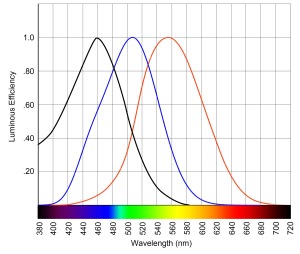A recent article in The Wall Street Journal discussed the possibilities and benefits of lighting systems that shift color to mimic the changes in daylight. It’s a complicated subject so it’s not surprising that some of what’s reported is inaccurate, so let me clarify a few things.
First, our current understanding of how light affects our circadian rhythms is that a light activates a type of cell in the retina called intrinsically photosensitive retinal ganglion cells (ipRGC). These cells, unlike rods and cones, are unrelated to vision. The signal they send to the brain is received by the suprachiasmatic nucleus (SCN), which is the body’s hormone regulator. As the graph below illustrates, the ipRGCs are most sensitive to short wavelength (blue) light and, unlike rods and cones, are unaffected by long wavelength (red) light. (A more detailed explanation can be found in Chapter 16 of Designing With Light, and in this article from the Journal of Circadian Rhythms.)

The ipRGCs signal to the SCN, which keeps our circadian rhythms are kept in sync with the day/night cycle, seems to be affected by three factors: color balance; intensity; timing. Cool (bluish) light should be delivered at a relatively high brightness in the morning hours. Delivering cool light in the evening hours can disrupt sleep and other processes controlled by the SCN.
Next, there’s nothing special about LED lighting that makes it uniquely appropriate for this application. Fluorescent, HID, and incandescent light (adjusted with color filters) can all be used to create a system that delivers cool light in the morning and warm light in the evening. In all cases, this involves the use of light sources of several tints (warm, cool, and possibly neutral) that are individually controlled. The WSJ is completely wrong when it says “unlike incandescent or fluorescent lights, LED lights’ materials and electronic components allow for finer adjustments of color, brightness and intensity.” A single LED creates light of a single color. To shift colors a second LED is required. Brightness and intensity are the same thing. With LEDs set to surpass sales of all other light sources within the next several years, research involving sources other than LED is nearly non-existent. Naturally, researchers are using LEDs to test theories and to develop demonstrations and products.
Finally, it would be helpful if the WSJ had defined two terms – color temperature and CRI (Color Rendering Index). Both are explained in Chapter 8. Color rendering and CRI are briefly explained in this post. CRI and color temperature are both addressed in this post.
